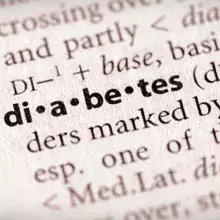24 million Americans have diabetes and 33% of them don’t even know it! Diabetes can lead to many complications - since it is a disease of the vessels: heart disease, kidney disease, blindness, nerve damage and amputation are some of the problems that can result from uncontrolled diabetes. The good news is that diabetes can be managed by you! With proper education, you have the power to avoid or reduce the severity of these complications.
You can make a life-changing difference by following these guidelines:
- Limit carbohydrates (starch, fruit, milk, sweets) at each meal or snack.
- Consume approximately 30-60 grams of total carbohydrate per meal (depending on your calories for the day and how your glucose is running).
- Consume approximately 15-30 grams of total carbohydrate per snack combined with a lean protein and/or unsaturated fat such as a yogurt with nuts or a fruit with low-fat cheese.
- Evenly distribute carbohydrates throughout the day to avoid fluctuations in blood sugar and to achieve a level blood sugar.
- Consume slow-digesting foods or food combinations to assist you in achieving a more level blood glucose. Consume the following foods in combination:
- High fiber carbohydrates (30-50 grams a day) like brown rice, whole grain breads or cereals, grains such as kasha, barley or millet.
- Lean protein such as fish, shellfish, poultry, lean meat and low-fat cheese.
- Unsaturated fat such as nuts, nut butters, avocado, oils.
- Test your blood sugar before meals and 2 hours from the start of the meal to determine if your body can handle the amount of carbohydrates you've eaten. If not, decrease the amount of carbohydrates or you may need a medication adjustment. For example: Test at 8:00 am before beginning breakfast and then again at 10:00 am.
- Look for the following results when testing blood sugar:
- Before meals blood sugar should be 90-130 mg/dL (American Diabetes Association - ADA guidelines*) or 80-110 (American Association of Clinical Endocrinologists - AACE guidelines**)
- After 2 hours blood sugar should be under 180 mg/dL* or under 140 mg/dL**.
- Blood sugar can expect to rise about 30-50 points from a meal.
- Eat every 3-4 hours so your blood sugar doesn't drop or fluctuate too much. This may determine whether a snack is necessary or not. Eating more frequently prevents over-eating at the next meal or snack and keeps your metabolism higher so you burn more calories!
- Wait 2 hours between meals and snacks so the blood sugar has a chance to come down before you send it back up with your food consumption.
- Have your doctor do a blood test to determine your 3-month blood sugar average. HbA1c also known as glycohemoglobin or hemoglobin A1c shows the progress you are making every few months with controlling your diabetes. Look for a number of 7% which is equivalent to154 mg/dL* or 6.5% which is equivalent to 140 mg/dL**, for best control. Fructosamine is a similar test that averages two week's worth of blood sugar results.
- Remember to exercise at least 5 days a week for 30 - 40 minutes. This includes walking, bicycling, strength training, etc. Exercise helps insulin work more efficiently to lower your blood sugar.
- Be sure to meet with a team of diabetes experts. They will provide you with the knowledge you need to control your blood sugar. There may need to be adjustments with times of exercise, medications or food choices for best glucose control.
There are no secrets when managing diabetes. You have all the tools you need to find out how food, exercise, medications and even stress affects your glucose readings. In time, you will learn how to fine tune and better manage your disease. The HbA1c will tell you what range your blood sugar is in. Your glucose monitor will provide you with critical information so you can find out how daily living affects your blood sugar. Don't allow the diabetes to rule your life when you are in charge!
Contributor: Marci Sloane, MS, RD, LD/N, CDE.

